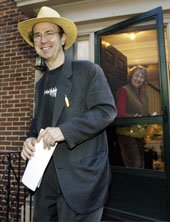 |
| Frank Wilczek and his wife Betsy Devine |
Frank Wilczek was in the shower when the call from Sweden came in at a little past 5 am last Tuesday. The theoretical physicist at MIT took the call ?dripping wet,? he said five hours later, speaking to the media for the first time as a Nobel laureate in physics. In a half-hour interaction with the media, amidst other faculty and students, at the Marlar Lounge in a building that is home to MIT?s Centre for Space Research, Wilczek described the sequence of events leading to the Nobel prize-winning idea, the work itself, and also tackled a question about the applications of the physics of elementary particles.
He shares the prize with his former thesis advisor David Gross, now at the University of California, Santa Barbara, and David Politzer, a physicist at the California Institute of Technology, who was a graduate student at Harvard, independently trying to understand the mysterious force that holds atomic nuclei together. Using just pencil and paper, the three physicists performed calculations to propose a paradoxical, almost counter-intuitive idea that the force between the elementary particles called ?quarks? which make up protons and neutrons increases as they move away from each other and weakens as the particles come closer to each other.
Today, their mathematical calculation is a routine homework assignment for graduate physics students. ?But back then, the mathematical tools they used were nascent and fraught with subtleties,? said John Preskill, a theoretical physicist and colleague of Politzer at Caltech. The 2004 physics prize acknowledges work done over 31 years ago. Wilczek was 21 when, working with Gross, he outllined the properties of the force that holds atomic nuclei together. Politzer?s paper in 1973 inaugurating his Nobel prize-winning work was his first published paper.
In between figuring out the force that binds atomic nuclei, Wilczek met his future wife, Betsy Devine, at Princeton, who was also pursuing graduate work there. ?It was during the time that I was meeting and courting Betsy, that I did this work and I don?t think that?s a coincidence,? he said. Sharing an anecdote about meeting her husband, Devine recalled last week that at Princeton in 1972, Wilczek was among students who watched and heckled the TV during broadcasts of the Bobby Fisher versus Boris Spasky games. ?I noticed that whatever moves Frank called out, the players would do what he said.?
Wilczek said the discovery didn?t come out of thin air. ?We stood on the shoulders of giants, a few reasonably tall people, and some average height people,? he said referring to foundations laid by other scientists. He cited the the work of physicist Murray Gell Mann who saw patterns in the hundreds of particles observed in the 1960s and proposed the existence of quarks and that of physics Nobel laureates Jerome Friedman and the late Henry Kendall of MIT and Richard Taylor of Stanford Linear Accelerator Centre. ?They used a ?microscope ? but not the kind you get in a hardware store ? to peer at the insides of protons and neutrons.?
Wilczek said basic physics research may have spinoffs that aren?t visible right now. However, challenging problems that push the frontiers of experimental physics and computer technology may also provide inspiration for young people. ?Basic research has paid off in recent history,? he said, citing the example of the worldwide web which emerged from work done at CERN, a particle accelerator laboratory in Geneva, Switzerland.
The familiar forces of electromagnetism and gravity fall with distance. But not the strong interaction. Gross, Politzer and Wilczek defined the force between quarks that becomes stronger the further quarks move away from each other. It?s something like the behaviour of a rubber band. It explains why free quarks cannot be observed. Hundreds of experiments in particle acclerators have confirmed this concept. The most dramatic of experimental consequences ? that protons viewed at higher resolutions would appear as ?soft glue? ? was only verified in the 1990s.
For Caltech?s Politzer, the Nobel prize isn?t the first foray into public limelight. In 1989, he was recruited to play a physicist in the movie Fat Man Little Boy. Politzer who didn?t even own a television set at the time, later told Caltech?s publication On Campus that he had been reluctant to take on the role, but relented after director Roland Joffe convinced him that it 'would not require too much in the way of time or talent'. However, on the movie sets, Politzer enjoyed the project and shared a spaghetti and salad dinner with Paul Newman.










